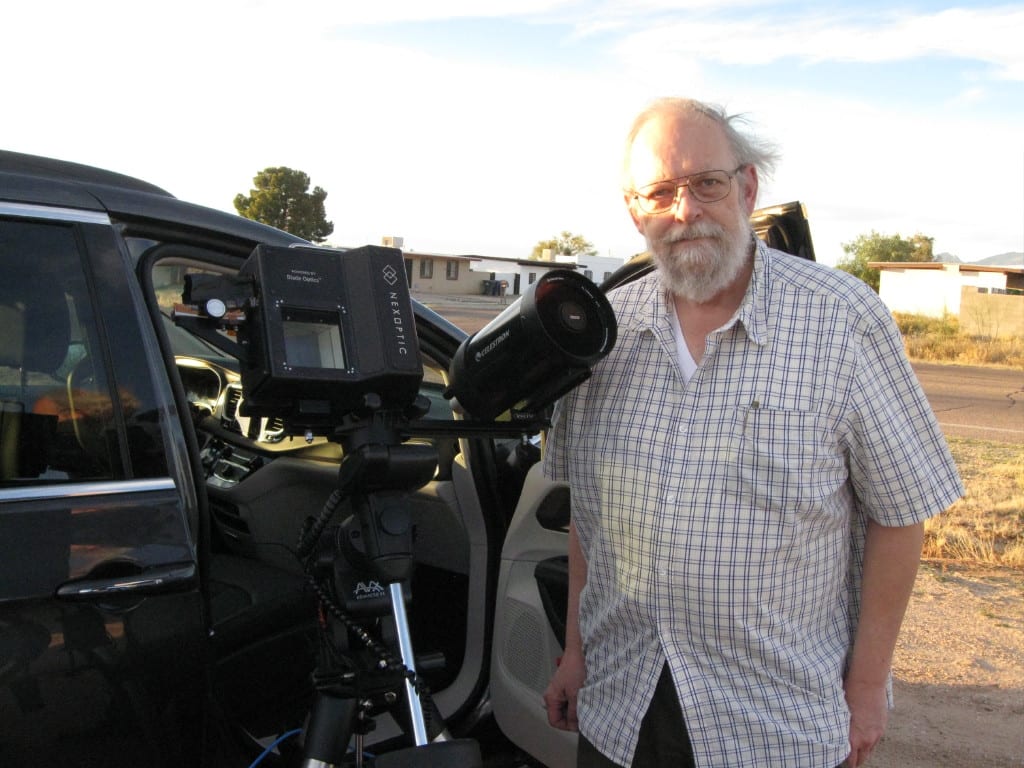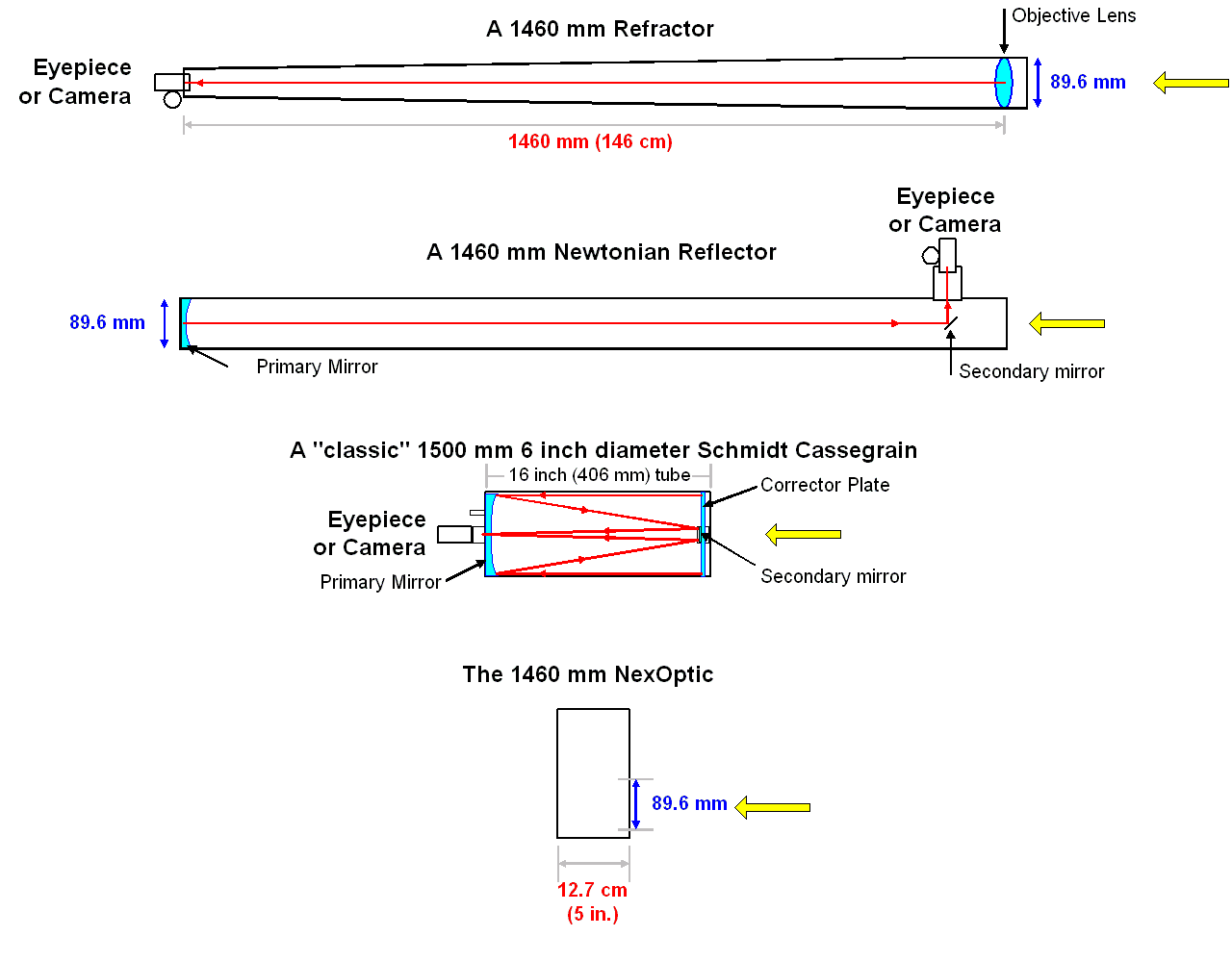By Larry McNish

The picture above shows myself with an equatorial telescope mount and a two telescope configuration.
The black box on the left is a telescope – the NexOptic Telescope (really!).
Although only 5 inches “thick” it has a focal length and field of view similar to the
Celestron 5 inch (127 mm) diameter Schmidt-Cassegrain telescope on the right.
Evaluation of The NexOptic Telescope
On February 7th I was invited to travel to Tucson, Arizona to evaluate and take astrophotographs through the world’s first fully-functional prototype of a totally new advanced optical system.
I had never heard of a telescope like this one, which was designed and built by NexOptic Technology Corp. (“NexOptic”) (TSX-V: NXO) (OTCQB: NXOPF) and Spectrum Optix Inc. of Calgary, Canada, (with the assistance of Ruda Cardinal Inc.).
- A square objective which is neither a round objective lens nor a reflective mirror?
- An objective focal length of ~1460 mm in a package only 12.7 cm (5 inches) thick?
After a quick meeting with Rob Cardinal (who many of you Calgary RASC people know from his discovery of two comets using the Rothney Observatory’s Baker-Nunn telescope) I was absolutely convinced I had to try out this new design.
Over the next 3 days, I had the opportunity to work with the NexOptic scope and it’s companion scope (shown above), setting them up, taking them down, transporting them around, and imaging daytime and nighttime objects.
Each scope was fitted with identical FLIR (formerly Point Grey Research, Inc.) BLACKFLY S USB 3 imagers for their optical calibration purposes. I downloaded the FLIR camera’s Spinnaker software to my own laptop, and off I went.
Target #1 was the Moon. With a focal length of 1460mm and the camera’s small sensor size, the field of view was just 0.2 degrees – less than half the width of the Moon. And it was a Full Moon at the time. Nevertheless I was easily able to use the laptop to target, focus and capture multiple images and darks from both scope/camera setups in a “panorama” sequence covering the whole Moon.
Target #2 was daytime shots of distant mountains around Tucson, again taken with both scope/camera setups.
Target #3 was star shots, but the nearly Full Moon and significant mechanical problems with the equatorial mount (not the scopes) prevented this.
Images (and darks) were taken in TIFF format so that they could analyze the prototype’s optical performance at the highest color depth.

Using the dual-mounted scopes on the equatorial mount to take mountain shots.
(Yes – they look funny positioned that way, but you can’t “bend” an equatorial mount
to force it to take Alt-Azimuth photographs, nor did I want to set the latitude to 0 since
the counterweights could have hit the tripod legs, and I didn’t have a tripod with a dovetail bar top.)
A scale schematic comparison of traditional telescopes versus the NexOptic
The scale diagram I created below shows how the physical length of similar focal length telescopes changes with the optical design.
The current industry “Champion” for amateur long focal-length telescope compression is the Schmidt-Cassegrain design using a thin corrector lens, a spherical primary mirror, and a further correcting secondary mirror. I own two of these 8 inch scopes, one on an equatorial mount, and (my favorite) on a Fork-Mount-Housing and an equatorial wedge for long-duration astrophotography.

Evaluation
Although I am under a non-disclosure agreement at this time, and cannot reveal technical details of its patent-pending design and construction, or the images I took (which are being examined as carefully as one does when doing the final polishing of a reflector telescope mirror), I have been given permission to describe my evaluation of the unit as follows:
- The first time I was handed the unit I thought to myself “Where’s the rest of it?” There is no power cable since the telescope does not contain any electronics. I just added the USB cable to the FLIR camera and I was ready to image.
- The physical length (i.e. “thickness”) of the NexOptic was a surprise! I never would have thought you could squeeze 146 cm (1460 mm) of focal length into just 12.7 cm (5 inches).
- The operation and imaging was remarkably easy for what I was told was considered a prototype instrument.
- The field of view was narrower than the 1250 mm Schmidt-Cassegrain as it should be for a 1460 mm focal lens scope.
- The Celestron Advanced VX Equatorial mount had no problem pointing, and tracking with both scopes mounted, so the weight is simply not a factor.
- We transported it in a padded case (like any high quality telescope), in a rental car, all over Tucson. No “re-collimation” was needed. In fact I didn’t see any adjustments (other than focus) on the scope body at all.
Conclusion
I’ve observed and imaged through a lot of different shapes and sizes of telescopes over the last 30 years, and having had the opportunity to take images with the NexOptic prototype, I believe that they have potentially created a “paradigm shift” innovation in optical design.
It seems to me that their “Blade Optics” is the biggest change in the fundamental design of long focal length telescopes since Newton replaced Galileo’s lenses with mirrors.
– Larry McNish
This article has been republished with permission. The original article can be found at http://calgary.rasc.ca/nexoptic.htm. For republication rights, please visit: http://calgary.rasc.ca/nexoptic.htm
Larry McNish is a member of the Royal Astronomical Society of Canada, an astronomer and astrophotographer for 30 years, and past president of the Calgary Centre of the Royal Astronomical Society of Canada. He has won multiple awards including the AstroImaging Award in 2006 and 2007 and also the Peter Sim Public Education Award in 2009.













This is a pile of rubbish. Look at the size difference of both of those . I don’t see any advantage what so ever. This is going to be a hard sell. I wouldn’t give you a plug nickel for that contraption. Don’t tell me that big box doesn’t have a pile of electronics inside it, because I won’t believe it. Just more stuff to go wrong.
That comment could easily have applied to the automobile.
Why are there no examples of these pictures?
Did you not even read the article?
Mark my words
The future of all communications from the net to tv and all photography and yes even telescopes
will not be done by mirrors glass and wires but will be done using light frequency as in lazors
The day will come that by lazor they will be able top look close up at a planet many light years away
and by using line of site and lazors the net will travel 7 times around the earth per second
and using lazor photography zooming close ups and high definition will take on a whole new meaning
but again this things are for tomorrow but again tomorrow is only a few hrs away for those that can see it
Duh! The USB cable provides the power. Of course there are electronics inside.
Ummm..the USB is the connection to the camera stupid…
Truly a breakthrough moment in photography and lens design. A comparison test without comparison images. Genius1
As an amateur astronomer, the objects picked are easily observed by the naked eye. Show me this thing displaying the horsehead nebula from a city location and I will be impressed. Show me it from a dark location and I might be impressed.
There simply isn’t enough information in the article to offer much of an opinion. We have to take the author’s word for everything. I’m not surprised there aren’t any electronics. Refractors, Reflectors, and Catadioptrics don’t have any electronics either. Only the mount and the cameras need power (and it wasn’t that long ago that weight-driven mounts were still being made).
This article is premature, since because of the non-disclosure agreement the author has with the builders… …the article has no information content.
It’ll be interesting to see what comes of this, if anything.
What makes the Blade Optics technology better or different from the other meta lenses currently under development?